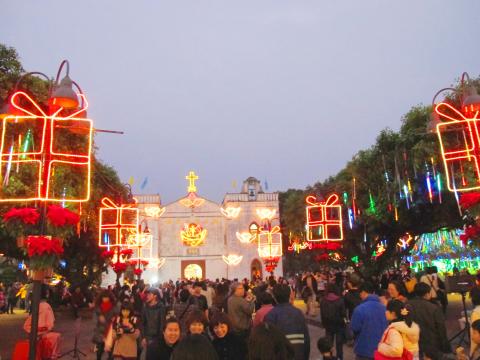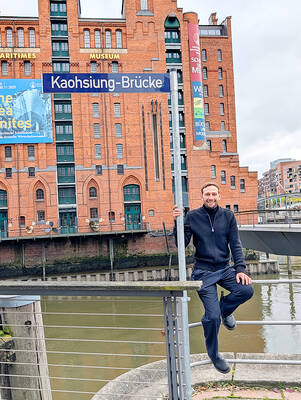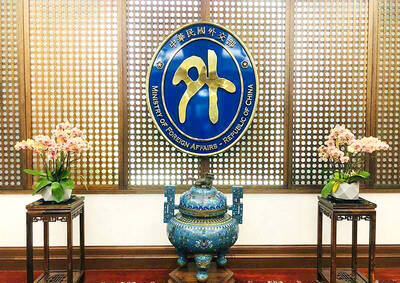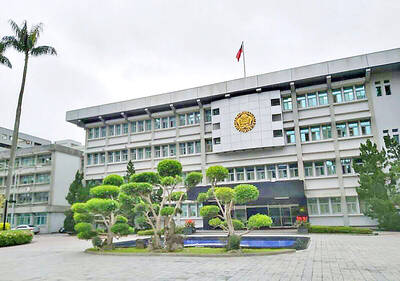Most people may not have expected it, but for residents in Pingtung County’s two small villages of Wanjin (萬金) and Chishan (赤山) — with a combined population of about 5,000 — Christmas is the most important festivity of the year, since about 80 percent of the villagers are Catholics.
One after another, fireworks were shot into the sky as Christmas songs were sung and a carriage, drawn by men in Santa Claus outfits and carrying two children dressed up as Joseph and the Virgin Mary holding baby Jesus, passed through the crowd. Church volunteers led the way, while onlookers took pictures of the parade.
In the past, the carriage was drawn by a cow. However, as the number of visitors grows, the church has decided to have people draw the carriage because a cow would be easily scared by the crowd.

Photo: CNA
“Merry Christmas. May peace be upon you,” the paraders and the onlookers said to each other, with smiles on their faces.
Many may have thought that parades on Christmas Eve only took place in predominantly Christian countries, but the residents of the two small villages neighboring Wanluan Township (萬巒) have celebrated Christmas for well over a century.
“We have just celebrated the 151st anniversary of the founding of the Wanjing Basilica, and we’ve always had a parade since the founding of the church here to express and share our joy for the birth of Christ,” said Pan Ching-yu (潘清雨), a priest at the basilica.
Prior to the parade, at the entrance of Chishan, a group of priests and young volunteers had traveled to another village named Jiazuo (佳佐), about 2km south of Chishan, to pick up the children dressed up as Joseph and Mary holding baby Jesus in a reconstructed stable, and paraded them through Chishan and Wanjin villages.
The parade ended at the basilica, where a mass was held.
The parade symbolizes the villagers welcoming Jesus and is also to spread the faith, said Baru, a priest of the Paiwan tribe.
“There are seven neighborhoods in Wanjin and Chishan, plus Jiazuo Village, so a total of eight communities in the surrounding areas of Wanjin Basilica take turns to stage the Nativity,” he said. “Representatives from the eight neighborhoods hold meetings to make the decision.”
Pan explained why there was such a concentration of Catholics in the two villages.
“The two villages were historically severely impoverished, but things began to change when the Spanish missionary Father Fernando Sainz arrived in Wanjin in 1861,” Pan said. “He made great efforts trying to help the villagers economically, while also mediating ethnic conflict. Through his acts of benevolence, he gained the trust of the people and a large number of people were converted to Christianity.”
For instance, many villagers at the time had to sell their land for cash, and without land, they would not be able to make a living, Pan said.
“So what Father Sainz did was purchase the land with church funds and continue to allow the original landowners to work their land,” he said.
Ethnic conflicts were also a serious problem because Wanjin and Chishan are Hoklo-speaking villages surrounded by Hakka-speaking and Paiwan Aboriginal communities, Pan added.
In fact, although Wanjin and Chishan are Hoklo-speaking villages, the majority of the villagers are descendants of the Makataos, a Pingpu Aboriginal tribe.
Christmas celebrations have long attracted Catholics from across the country and promotion by the Pingtung County Government since last year has made it a popular event even for non-Christians.
Like most other events attracting large crowds of visitors, the tens of thousands of visitors pouring into the villages on Christmas Eve also had some negative impact.
“I noticed there is a lot of trash on the ground,” one storeowner in Wanjin said. “Plus, when you have so many people here, you would expect that your business would grow, but it’s not the case because most of the hundreds of stalls are from other places.”
Wanjin Village Chief Pan Jung-hsin (潘榮信) agreed that the overwhelming crowds and the street vendors have tarnished the sanctity of the religious event.
“We certainly welcome everyone to come here to share our joy, and we also welcome vendors from anywhere to come and make some money,” he said. “However, whether you are here as a visitor or a vendor, you must bear in mind that this is a religious event and religious factors should always be kept as the core of the event.”
For example, some vendors have wanted to set up their stalls right at the front gate of the basilica, he said.
“We asked them to move elsewhere, but they refused and had a fight with us,” he said. “Although they eventually moved away because we insisted, incidents like these are really troubling.”
According to Pan Jung-hsin, visitors in the past were amazed by the Christmas decorations outside houses in the village, but the decorations are less visible now because street vendors’ booths have blocked the view of most of the houses there.
He called on the county government to put more effort into managing the event, rather than just promoting it.
“I’m happy to see so many people enjoy taking part in our Christmas celebrations, and I’m equally happy to see our village becoming more visible through the events,” he said. “With more communication [with the county government] on how to better manage the vendors, I believe the event will improve every year.”

The German city of Hamburg on Oct. 14 named a bridge “Kaohsiung-Brucke” after the Taiwanese city of Kaohsiung. The footbridge, formerly known as F566, is to the east of the Speicherstadt, the world’s largest warehouse district, and connects the Dar-es-Salaam-Platz to the Brooktorpromenade near the Port of Hamburg on the Elbe River. Timo Fischer, a Free Democratic Party member of the Hamburg-Mitte District Assembly, in May last year proposed the name change with support from members of the Social Democratic Party and the Christian Democratic Union. Kaohsiung and Hamburg in 1999 inked a sister city agreement, but despite more than a quarter-century of

The Ministry of Foreign Affairs (MOFA) yesterday expressed “grave concerns” after Singaporean Prime Minister Lawrence Wong (黃循財) reiterated the city-state’s opposition to “Taiwanese independence” during a meeting with Chinese Premier Li Qiang (李強). In Singapore on Saturday, Wong and Li discussed cross-strait developments, the Singaporean Ministry of Foreign Affairs said in a statement. “Prime Minister Wong reiterated that Singapore has a clear and consistent ‘one China’ policy and is opposed to Taiwan independence,” it said. MOFA responded that it is an objective fact and a common understanding shared by many that the Republic of China (ROC) is an independent, sovereign nation, with world-leading

The Ministry of Justice Investigation Bureau (MJIB) has been investigating nine shell companies working with Prince Holding Group, and the Taipei District Prosecutors’ Office is seeking further prosecution of alleged criminals, a source said yesterday. The nine companies and three Taiwanese nationals were named by the US Department of the Treasury’s Office of Foreign Assets Control (OFAC) on Oct. 14 as Specially Designated Nationals as a result of a US federal court indictment. Prince Holding founder Chen Zhi (陳志) has been charged with fraud, conspiracy, money laundering and overseeing Prince Holding’s suspected forced-labor camps in Cambodia, the indictment says. Intelligence shared between Taiwan,

COOLING OFF: Temperatures are expected to fall to lows of about 20°C on Sunday and possibly 18°C to 19°C next week, following a wave of northeasterly winds on Friday The Central Weather Administration (CWA) on Sunday forecast more rain and cooler temperatures for northern Taiwan this week, with the mercury dropping to lows of 18°C, as another wave of northeasterly winds sweeps across the country. The current northeasterly winds would continue to affect Taiwan through today, with precipitation peaking today, bringing increased rainfall to windward areas, CWA forecaster Liu Pei-teng (劉沛滕) said. The weather system would weaken slightly tomorrow before another, stronger wave arrives on Friday, lasting into next week, Liu said. From yesterday to today, northern Taiwan can expect cool, wet weather, with lows of 22°C to 23°C in most areas,